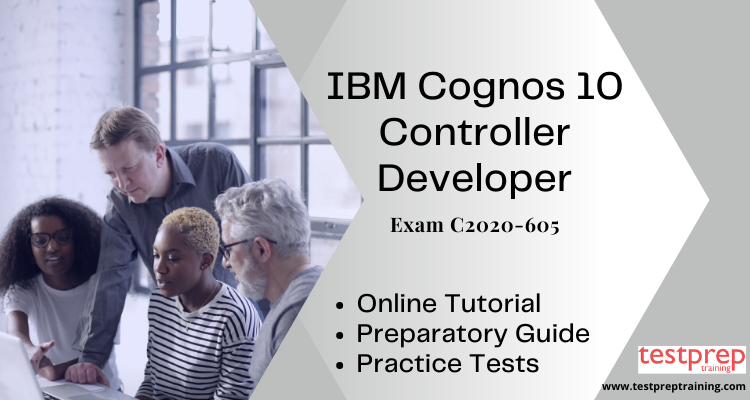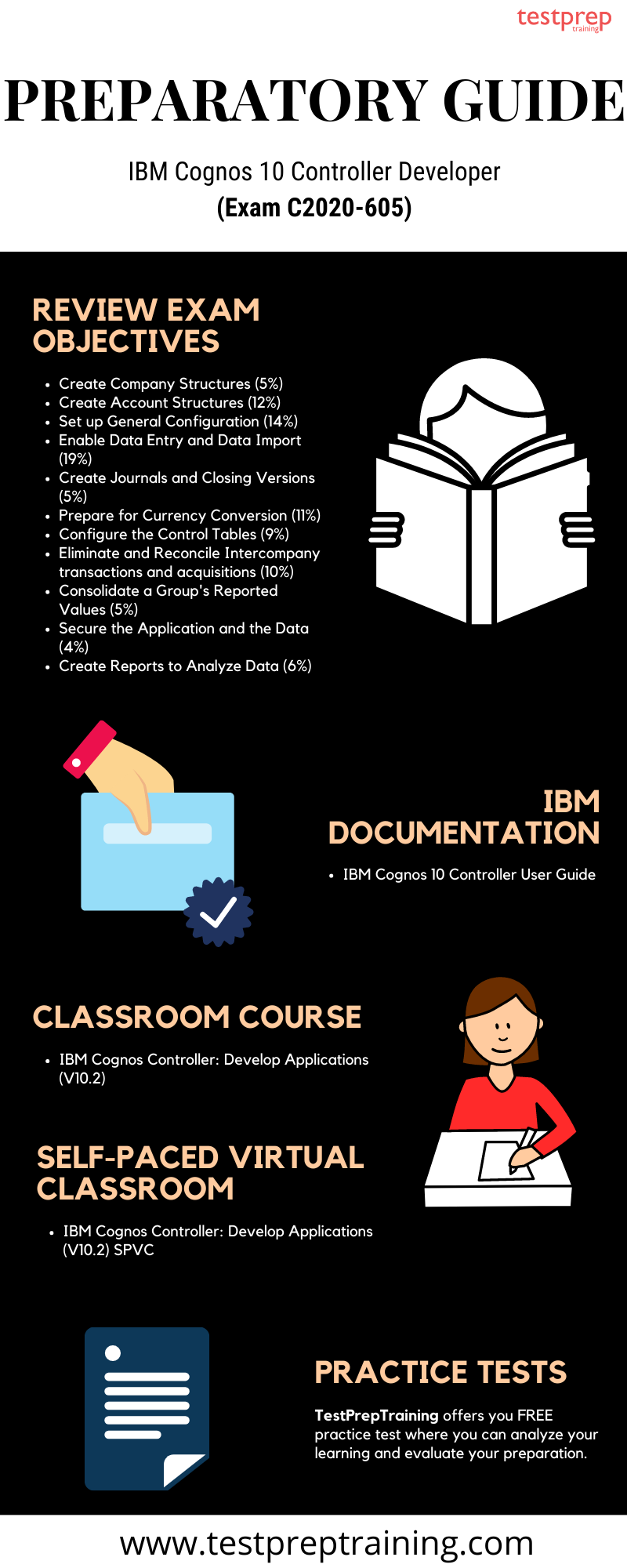(C2020-605) IBM Cognos 10 Controller Developer

(C2020-605) IBM Cognos 10 Controller Developer exam will certify that the successful candidate has important knowledge and skills necessary to set up a Controller application by creating account and company structures, and set up the consolidation processes such as currency conversion, intercompany transactions, and investments in subsidiaries. The successful candidate must also be able to design and generate financial reports used for financial analysis.
Exam Pre-requisites
Prior to your preparation for this associate-level certification, the following knowledge and skills are recommended and assumed:
- Knowledge of IBM Cognos 8/10 Cognos Connection
- Knowledge of IBM Cognos 8/10 Controller Configuration
Exam details
| Exam Name | IBM Cognos 10 Controller Developer |
| Exam Code | C2020-605 |
| WorldPartner Code | 47010302 |
| Exam Partner | Pearson VUE |
| Number of Questions | 94 |
| Exam Duration | 120 minutes |
| Passing Score | 78 correct answers out of 94 questions |
| Exam Language | English |
| Exam Format | MCQ’s |
| Exam Fees | US$200 |
Exam Retake Policy
If you are not able to make it in the first attempt, there is no waiting requirement before the second attempt. However, you may not take the same exam more than twice within any 30 days of time. The second attempt requires repayment of the fees.
C2020-605 – Frequently Asked Question’s
To get all of your queries regarding the C2020-605 exam resolved, visit: (C2020-605) IBM Cognos 10 Controller Developer: FAQ’s.
Course Outline
The Exam C2020-605 outlines the following topics:
Create Company Structures (5%)
- Distinguish between the company types
- Describe how consolidation types settings affect the company structures
Create Account Structures (12%)
- Describe how the reconciliation between accounts settings handles reconciliation of opening balances
- Describe the effect of entering an investment code for an account
- Also, describe a scenario for using movement accounts
- Identify how to generate movement accounts
- Describe the effect of using statistical and non-statistical account types for movement accounts
- Identify how integrated and non-integrated movement accounts affect reconciliation
- Describe the benefits of connecting extended dimensions to accounts
Set up General Configuration (14%)
- Distinguish between weekly/daily actualities and linked actualities
- Describe the effect of enabling the advance account view setting
- Describe the benefits of using multiple submission
- Also, describe the effect of enabling Set Status for Submission to Ready After Reconciliation
- Distinguish between reconciliation made by Journal Type and Closing Version
- Describe how the reporting status is affected by reconciliation settings Total Difference and Difference per Row
- Using Method 1, distinguish between currency conversion differences account1 and currency conversion differences account2
- Describe the impact of main settings and the reserves
- Explain the impact of changing account type settings
Enable Data Entry and Data Import (19%)
- Distinguish between different form types
- Describe the purpose of forms sets
- Describe the impact of using multiple submissions with form sets
- Also, describe any of the functions of the Form Properties
- Describe how to use linked structures to limit data entry view
- Distinguish between using the data entry view and the Excel link to add data
- Describe the process of adding movement accounts to forms
- Describe a scenario for creating a link between forms
- Identify the different structures that can be imported and the process
- Identify the different ways that data can be imported into Controller
- Describe the process of creating an import specification
Create Journals and Closing Versions (5%)
- Define the relationship between journal type and closing version
- Identify the two ways to enter data into company journals
- Describe scenarios for copying journals from one period to another
- Determine the impact of adjusting data on group journals versus company journals
Prepare for Currency Conversion (11%)
- Identify when rules for currency conversion are defined
- Identify the workflow for converting foreign currency
- Using currency conversion Method 1, identify the commonly used currency codes for P&L accounts, Balance Sheet accounts, and Equity accounts
- Distinguish between the currency register and the historical register
- Describe a scenario for entering historical rates when a company rolls up to several group currencies
- Distinguish between currency conversion codes C and I when converting values for a company journal
Configure the Control Tables (9%)
- Explain the purpose of acquisition control tables
- Explain the purpose of intercompany elimination control tables
- Identify the process for enabling automatic journal entries
- Identify the impact of the offset account in control tables
Eliminate and Reconcile Intercompany transactions and acquisitions (10%)
- Identify when counter dimensions are used
- Identify the ways intercompany balances can be eliminated
- Also, identify the effect of storing intercompany adjustments as group journals
- Identify how to enter data in the investment register for subsidiaries and associated companies
- Explain scenarios when no balance control would be used in the investment register
- Describe the importance of defining a start period for acquisition calculations
- Describe the ways to run reports for reconciling data reported as intercompany balances
- Identify the impact of using Use Online Matching
Consolidate a Group’s Reported Values (5%)
- Distinguish between consolidating by steps and consolidating by status
- Identify the reports needed to analyze consolidation
Secure the Application and the Data (4%)
- Describe the benefits of creating security groups
- Describe the benefits of creating user rights
- Moreover, describe how using period locking at a company level affects the closing version
- Distinguish between locking the period for data entry only and locking the period entirely
Create Reports to Analyze Data (6%)
- Identify the performance considerations when creating reports
- Distinguish the benefits between creating a Report Generator report and an Excel Link report
- Describe the Report Conversion functionality when creating user-defined reports in Controller
Preparatory Guide for C2020-605 exam
Before you get started, you must refer to the following preparatory guide that mentions all the relevant and possible learning resources that are ideally required for the exam preparation.

Review Exam Objectives
Visit the IBM Official website, to have a better view of the exam guide. Analyzing the exam guide will let you align yourself more deeply with the chief objectives of the exam. Moreover, this will enable you to gain the required command to earn your desired certification.
- Firstly, create Company Structures (5%)
- Secondly, create Account Structures (12%)
- Thirdly, set up General Configuration (14%)
- Then, enable Data Entry and Data Import (19%)
- Also, create Journals and Closing Versions (5%)
- Further, prepare for Currency Conversion (11%)
- Configure the Control Tables (9%)
- Also, eliminate and Reconcile Intercompany transactions and acquisitions (10%)
- Moreover, consolidate a Group’s Reported Values (5%)
- Secure the Application and the Data (4%)
- Lastly, create Reports to Analyze Data (6%)
IBM Documentation
You can take the help of IBM documentation and refer to IBM Cognos 10 Controller User Guide for your exam preparation. Prepare your own unique strategy for studying and make sure you follow your timetable strictly. Self-study is the only thing that will take your preparation to the next level. This will not only help you correct your mistakes but increase your efficiency too.
Classroom Course
IBM Cognos Controller: Develop Applications (V10.2) is an intermediate five-day instructor-led training course. It is designed to teach application developers how to set up a Controller application and effectively use Controller in their organization’s consolidation process. Through a series of lectures and hands-on exercises, students will set up a Controller application by creating the necessary structures (such as accounts and companies), and then test the application to ensure that it works properly.
Self-Paced Virtual Classroom
IBM Cognos Controller: Develop Applications (V10.2) SPVC is the self-paced online version of the classroom course and includes hands-on remote labs. The average amount of time to complete this course is 5 days. Once you receive your access information, you will have 30 days to complete this course and its labs
Practice Tests
Self-evaluation provides you with greater insight into your preparation. Before the actual certification test, indeed, it is highly recommended to give practice tests. It will help you determine your skills and preparation, making you familiar with the exam pattern.
Assess your knowledge and evaluate yourself with the latest and updated practice tests that TestPrepTraining offers you for FREE!


